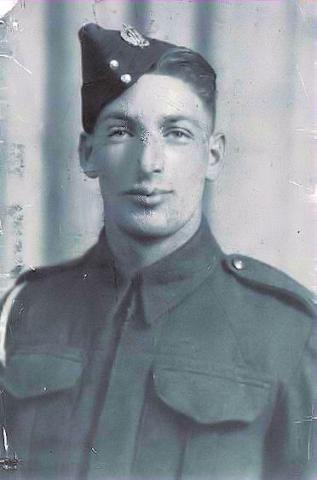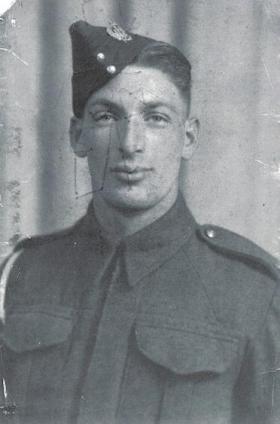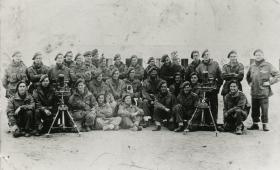Sergeant. Maurice Kalikoff. Mortar Platoon, 2nd Parachute Battalion.
Maurice Kalikoff was born on the 28 th April 1916, and as a child during the 1920’s, he had fled Russia with his parents, Phillip and Dora, and sister (Esther) and they made their way to Britain, where they settled in Islington, London. According to James Sims, in his book ‘Arnhem Spearhead’: “Maurice was a Russian Jew. He had been born in Kiev and his family had fled from Russia during a pogrom. He still retained the Slav’s sad, almost fatalistic, outlook on life and was quietly spoken - for a sergeant. He was a first-class soldier and one of the finest human beings I have ever met.”
He enlisted into The Essex Regiment on the 2 April 1940. [1] In late November 1941 he volunteered for Britain’s expanding Airborne Forces and after completing the selection process at Hardwick Hall he was sent to RAF Ringway to attend Parachute Course No 4, 17 – 23 December 1941. Amongst the ten Officers and 193 Other Ranks on the Course from throughout the 1st Parachute Brigade, were two Officers and 60 – 70 Other Ranks of the 2nd Parachute Battalion, mainly from Headquarter Company, of which, the then Private. Kalikoff was one. He completed the 2 balloon and 5 Whitley aircraft descents to qualify as an Army Parachutist. [2] He returned to RAF Ringway for the second ‘Advanced Parachute Course’, with arms containers, on the 14 to 19 January 1942. This consisted of three Officers and 205 Other Ranks all of the 2nd Parachute Battalion. The descents included a night time descent from the balloon and two ‘tactical’ aircraft descents. [2] Having completed all his parachute training Pte. Kalikoff joined the 3-inch Mortar Detachment of ‘B’ Company.
He served with them in North Africa, but in late 1942 these mortar Detachments were disbanded and a Medium Machine Gun Platoon was created for each battalion. Maurice, however remained as a mortarman, but now in the Mortar Platoon. By 1943 he had started to rise in rank and by the time of the operations in Sicily, and then Italy in September 1943, he was a Sergeant and a Section Commander.
In December 1943 the 2nd Parachute Battalion returned to the united Kingdom and the battalion headquarters and Headquarter Company were billeted at Stoke Rochford Hall in Lincolnshire.
He was a strict disciplinarian yet remained very popular with his men. James Sims wrote of him “Just before Arnhem, Maurice had a bee in his bonnet about us achieving a quick exit and a tight stick, so he had us hobbling through a nissen hut with a kit bag on our leg and with full equipment. As this was early September, it was very hot and uncomfortable and we moaned a bit, but Maurice was determined we would get it right.”
On Sunday, 17 September 1944, he took off from Saltby aerodrome in a C47 Dakota aircraft of the 314th Troop Carrier Group, USAAF bound for DZ ‘X’ near Renkum in Holland as part of
the 1st Lift of Operation ‘Market-Garden’. James Sims: “Lieutenant Woods as Number One was seated next to the open doorway. I was Number Fifteen and the man behind me, the last man out, was Maurice Kalikoff.”
After landing the individual men made their way to the battalion RV, which was being indicated by yellow smoke as well as the Commanding Officers hunting horn, James Sims again: “Looking like a Christmas tree, I set off in search of the 2nd Battalion. I met Sergeant Kalikoff, who appeared upset over something. When I asked what the trouble was he replied that he had lost his kitbag. At the thought of all those tedious and sweaty afternoons I burst out laughing. Maurice couldn’t see the joke and told me to get moving.”
After several hours the 2nd Battalion arrived at their main objective – the road bridge in Arnhem. A position was selected for the mortars, James Sims: “There was an island of grass with shrubs and trees in the centre of the road west of the bridge. Lieutenant Woods selected this for our mortar position. He ordered us to dig two pits for the mortars and to surround these with slit-trenches. Sergeant Kalikoff was left to organise this while the Lieutenant went off to inspect the house which was to be held by the rest of the platoon, and to see if its defence had been properly organised.”
Eventually, on Wednesday, 20 September, both mortars had run out of ammunition and the house was now the main defensive position for the Mortar Platoon. A building nearby was hit by
shells from a German Self-Propelled Gun and began to collapse with the impact of the shells. The Germans used a tactic of firing a burst of tracer from a machine gun, mounted on the SPG,
before firing with their main armament, the Mortar Platoon building was fired at next, James Sims: ‘A stream of tracer lashed out over our house, at which we all jumped to our feet and
turned towards the door - only to find Sergeant Jackman standing there grinning at us. “Just where do you lot think you’re off to?” The panic subsided, but when the sergeant ordered us
downstairs at the double we needed no second bidding. The remainder of the Mortar Platoon was clustered at the bottom of the stairs. From above Sergeants Jackman and Kalikoff surveyed what was left of the original ‘shower’. Sergeant Jackman was now in command of the platoon, Lieutenant Woods being presumed killed in the White House. Having inspected us Sergeant
Jackman said, “I want six volunteers to stay here with Maurice and defend this house to the last.” We all shuffled forward. “OK, Maurice, take your pick.” Sergeant Kalikoff looked us over
in his sad way and selected six of the toughest veterans in the room. Waving his hand in the direction of the garden Sergeant Jackman shouted, “Right, the rest outside and dig in.” We
tumbled out of the house and spread round the perimeter of the garden.’ When they ran out of ammunition, Sgt. Kalikoff and two of his men ran for the safety of another house, but Kalikoff was hit and wounded. He was taken prisoner, but died of his wounds on the 27 October 1944, aged 28. He is buried at the Rheinberg Cemetery in Germany, grave 12. K. 3.
The photo of him in uniform, was taken in 1940, when Maurice was serving with The Essex Regiment.
Notes:
[1] The Parachute Regiment, Transfer and Enlistment Book 03, page 44.
[2] Parachute Course Reports. RAF Ringway. December 1941 and January 1942.
Profile written by R Hilton. Profile photograph courtesy of Paul Pariso.
Read More



Latest Comments
We never met, as I was born after you were gone. Your sister Esther (my mother) loved you very much. She never forgot you and spoke of you often. She told us how handsome you were and you had beautiful blue eyes and red hair, and how much she missed you. I don't think she every truly got over loosing you.
Thank you for your bravery. I am here today because of you.
Much Love
Your niece, Pamela
Add Comment
In order to add comments you must be registered with ParaData.
If you are currently a ParaData member please login.
If you are not currently a ParaData member but wish to get involved please register.